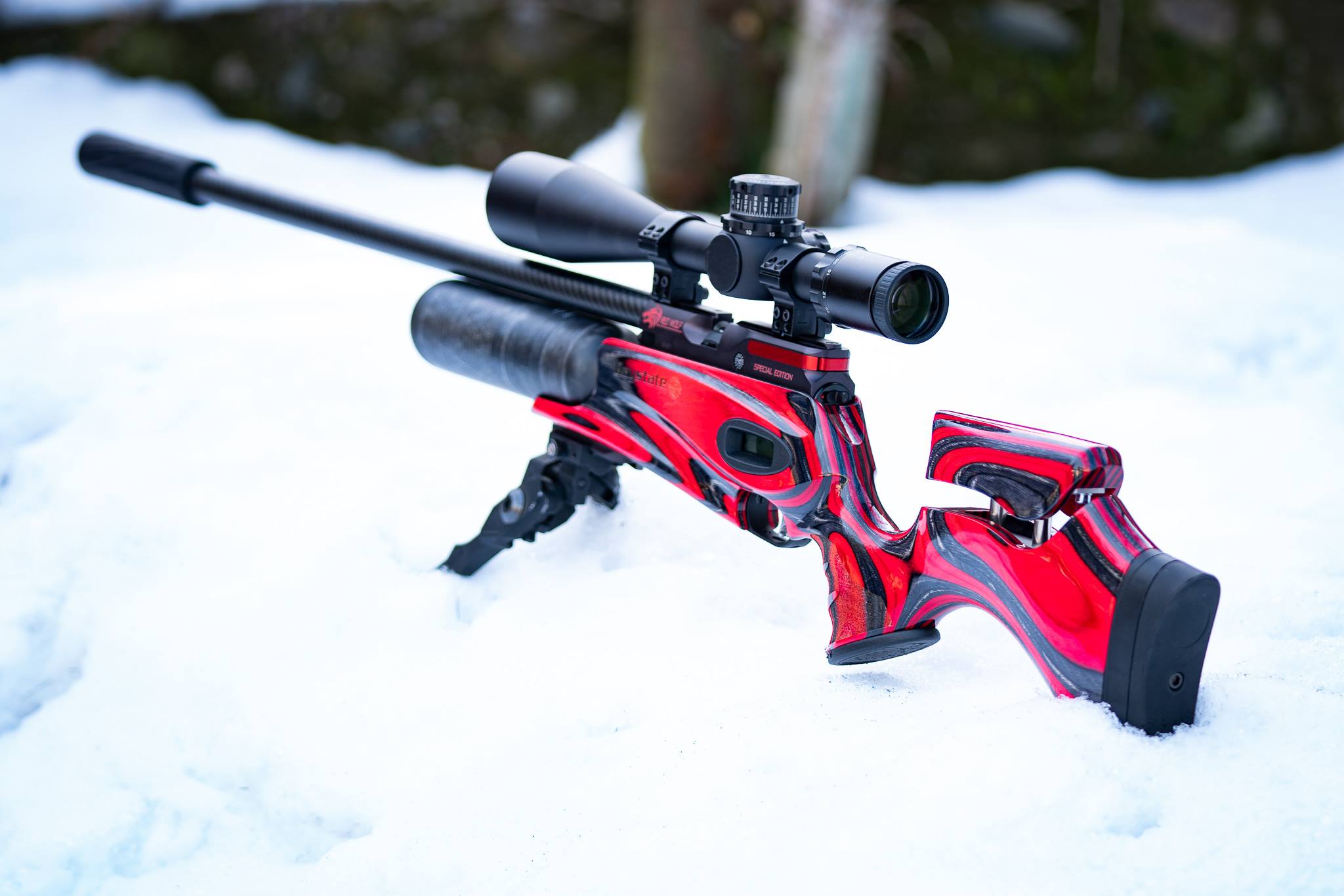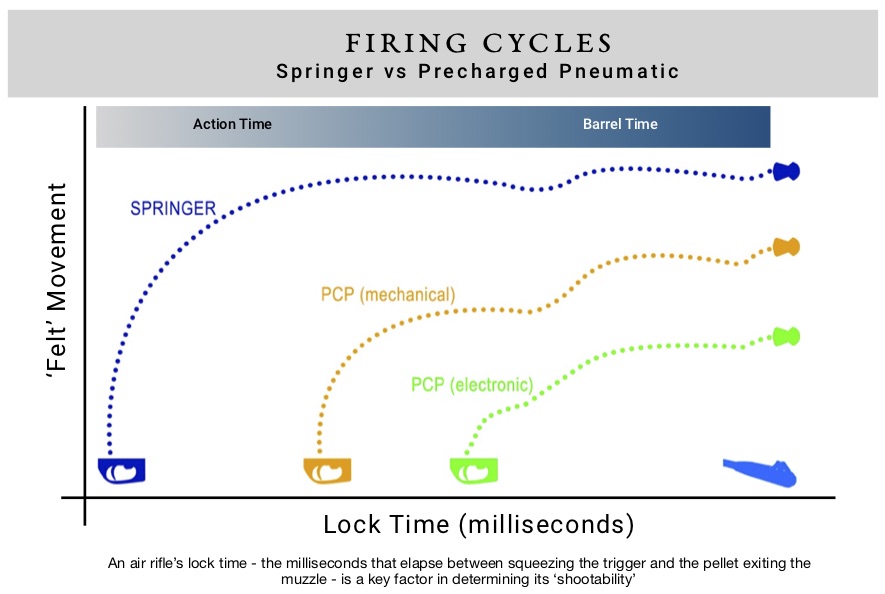The reason one air rifle is easier to shoot than another is the speed of its action.
An airgun’s firing cycle – the brief moment that elapses between the trigger’s sear being slipped and the pellet exiting the barrel – is more commonly called its lock time. It’s quick, typically lasting 15 milliseconds or less. Yet it is a vital characteristic of any airgun. In fact, lock time is a key reason why some guns are easier or ‘more forgiving’ to shoot than others.
In theory, the faster the lock time, the more accurate the rifle, though lock time is actually the sum of two other ‘times’ that, individually, contribute to an airgun’s overall firing cycle. These are the action time and the barrel time.
Barrel Time
On most airguns, the shortest element of lock time is barrel time, which obviously takes place at the latter end of the firing cycle. It refers to the time taken for the pellet to travel up the bore of the barrel, before exiting the muzzle. Relatively, there’s minimal difference in the overall lock time between a high-velocity pellet travelling up a short barrel and a low-velocity pellet travelling up a long barrel. In other words, barrel time isn’t the most influential element of an airgun’s lock time.
Action Time
What has the biggest effect on lock time is the action time. This refers to the beginning of the firing cycle, the instant the trigger breaks. Here, there can be huge differences according to the gun’s configuration. Spring-powered airguns (springers) have a longer action time than precharged pneumatics (PCPs). And the feel of PCP actions can vary hugely by design, with electronically-controlled PCPs offering the fastest action time of all.
In a springer, the action time commences with the piston travelling forward under pressure from the uncoiling mainspring. It continues with the piston ‘bouncing’ on a slug of high pressure air before finally ending when the piston comes to a crashing halt at the end of the compression cylinder. A springer’s action time will invariably run into its barrel time, because the pellet will have started its journey up the barrel before the piston finally bottoms out. However, the action time should, on a properly set-up springer, have ended before the pellet exits the muzzle.
In a mechanically-driven PCP, the action time begins with the hammer being driven forward under spring pressure. It continues while the hammer strikes and opens the valve, and effectively ends at the time the valve closes. This will pretty much be at the same instant the pellet starts to accelerate up the barrel. Of course, with a much smaller hammer and spring, not to mention stroke, the PCP’s action time is significantly shorter than that of a springer’s. It’s also the reason why a PCP’s firing cycle is, for all intents and purposes, recoil-free.
However, the action time can be even shorter on the ground-breaking electronic PCPs Daystate pioneered back in 2003. Their current flagship duo, the Pulsar and Red Wolf, use a solenoid in lieu of a hammer to open the valve so rapidly that, ironically, it’s the barrel time that becomes the most influential element of the gun’s lock time!
Red Wolf Serie Rosso- an electronically-driven PCP that boasts the fastest lock time of any air rifle

LOCK TIME – THE KEY
So, given lock time lasts only milliseconds or less, why does it have such an effect on an airgun’s ‘shootability’? Well, time really is of the essence because the longer it takes to get the pellet out of the barrel, the more chance the rifle has of moving off the mark you intended at the instant you touched off the trigger.
In a springer’s case, the shooter is not just fighting with recoil as the rifle shunts back-and-forth in reaction to the heavy piston’s movement. Time is also ticking away before the pellet begins its flight to the target. When you analyse the timeframe of a springer’s firing cycle, it’s a wonder anyone can achieve consistent accuracy! (This is why it’s often said that if you can shoot a springer well, you can shoot a rifle of any type.)
In a PCP’s case, there is little ‘felt’ recoil to trouble the shooter’s aim. However, there is still movement going on during the firing cycle, even if it’s minimal by comparison with a springer. Newton’s laws of motion will dictate that the rifle will be moving in your shoulder to counteract the momentum of the hammer’s travel and impact with the valve during its action time stage. So, the longer this takes, the more likely the rifle’s aimpoint will err between the trigger-break and pellet-exit points.
In addition, mechanically-driven PCPs can also have an action time that varies according to its charge state. In the simplest knock-open valve designs, there is a slower action time the further into the air charge you go, and also a noticeable change in the movement of the rifle as its cylinder’s air pressure drops behind the firing valve. This makes it physically harder for the shooter to achieve consistent results.
This isn’t such a problem with the more sophisticated PCP designs, like the Slingshot hammer and valve system used on some mechanically-driven Brocock and Daystate PCPs. But the fact remains, where all other things are equal, a PCP with an action time of seven milliseconds will be easier to shoot accurately than one with an action time of 11 milliseconds. Even if four thousandths of one second doesn’t sound enough to affect the shot, the truth is: it does!

Which is why Daystate’s electronically-controlled PCPs are so easy to shoot accurately. Their action time – and so the rifle’s overall lock time – is reduced by such a considerable amount that it’s not uncommon to ‘call’ a miss… only to find you’ve landed the shot plumb centre at the target!
By comparison with mechanically-driven PCPs, the digital action of an electronic PCP reduces action time by roughly 90 per cent, effectively making barrel time the only element of its firing cycle. Typically, the overall lock time is reduced to around just five milliseconds; so fast, in fact, that the rifle can feel quite ‘dead’ on firing.
With computerised control of the valve and air delivery in the shape of MCT (Mapped Compensated Technology) also integral to Daystate’s high-tech PCPs, shot release is as consistent as it is quick. This is why rifles like the Pulsar and Red Wolf are so easy to shoot well with – their lock time simply doesn’t give the shooter long enough to flinch a shot off target!
